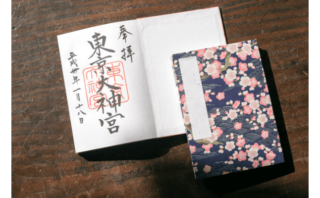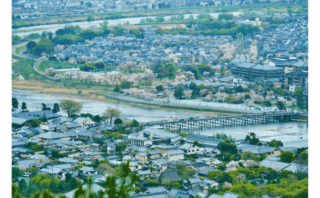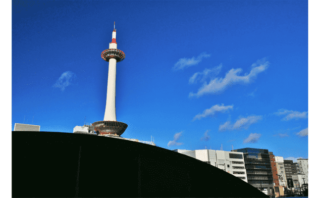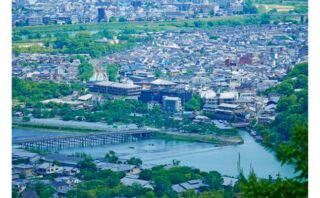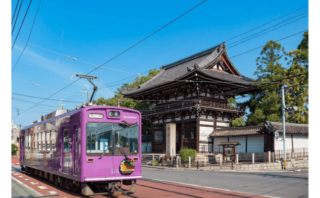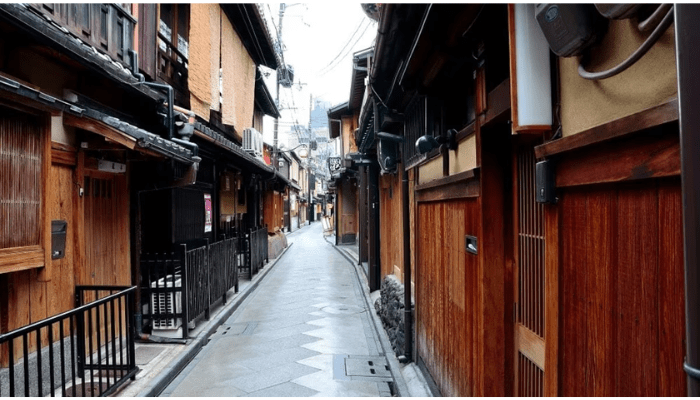Saiho-ji, also known as Kokedera (the Moss Temple), is famous for its stunning garden covered in lush green moss. Unlike the busy tourist spots in Kyoto, this temple offers a peaceful and quiet retreat.
As you walk through the serene, moss-covered garden, you can experience the fading essence of Zen philosophy—a moment of reflection and tranquility.
In this article, I’ll share my firsthand experience visiting Kokedera, along with photos and key highlights of the temple. You’ll also find essential information on how to make a reservation in advance (required for entry), how to get there from central Kyoto, and important etiquette to keep in mind when visiting.
By preparing ahead of time, you can make the most of your visit to this breathtaking temple. Let’s explore the magical world of Kyoto’s Moss Temple!
What is Kokedera (Saiho-ji Temple)?
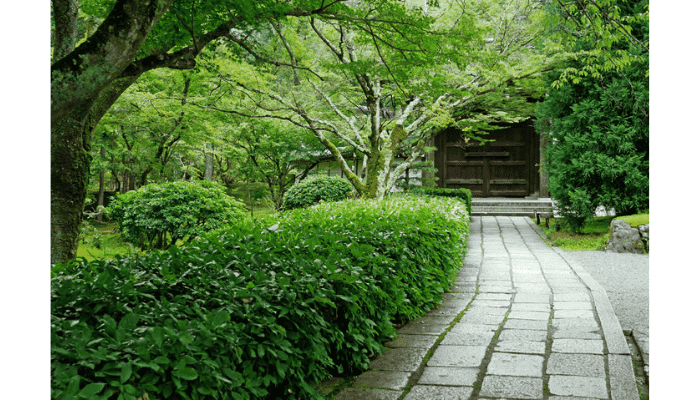
Nestled in Kyoto’s Rakusai area, Saiho-ji, commonly known as Kokedera (the Moss Temple), is one of Kyoto’s most enchanting temples. Loved by both Japanese visitors and travelers from around the world, this historic temple is famous for its breathtaking moss-covered garden.
Before diving into the highlights of Kokedera, let’s go over its history, reservation process, and admission fees.
Overview
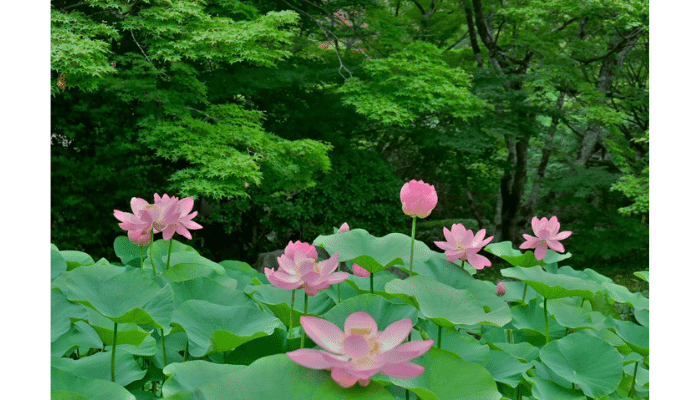
Located in Nishikyo Ward, Kyoto, Saiho-ji is a Rinzai Zen temple with a vast garden covered in lush moss, which is why it is affectionately called Kokedera (Moss Temple).
The temple has a long history, with notable figures such as Ashikaga Yoshimitsu and Yoshimasa visiting for Zen meditation. Its dreamlike scenery led to its designation as a UNESCO World Heritage Site in 1994.
In recent years, the global popularity of Zen philosophy has drawn visitors from all over the world. Even Steve Jobs is said to have visited this sacred site.
Although the temple has a strict advance reservation system and limits the number of visitors, its tranquil atmosphere continues to attract people seeking peace and spiritual reflection.
History of Saiho-ji Temple(Kokedera)
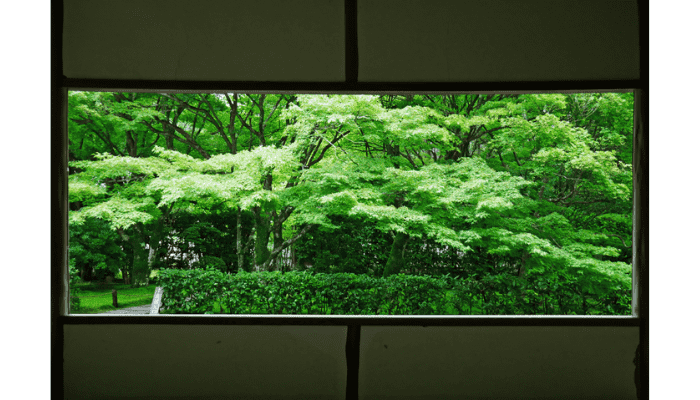
Saiho-ji was originally founded during the Nara period (8th century) by the Buddhist monk Gyoki. In the early Kamakura period (12th century), the temple was converted to the Jodo (Pure Land) sect by Honen, a key figure in Japanese Buddhism.
Later, in 1339, the renowned Zen master and landscape designer Muso Kokushi transformed the temple into a Zen monastery and created the breathtaking moss garden seen today.
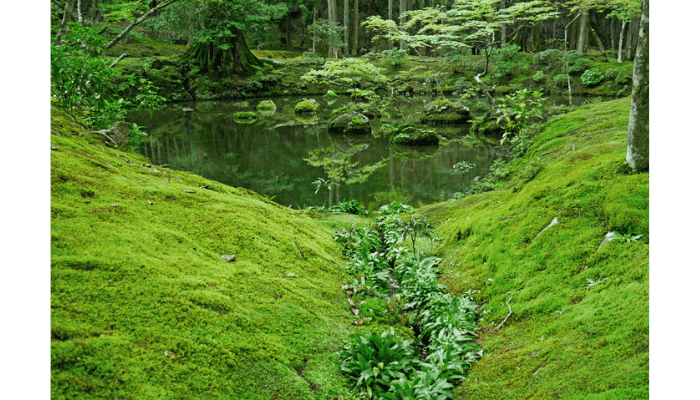
Saiho-ji is also said to have once been a villa of Prince Shotoku. Throughout its long history, the temple has faced numerous challenges, including two religious conversions, wars, and floods, but it has been rebuilt each time. In 2031, Saiho-ji will celebrate 1,300 years since its founding.
At one point, the temple was completely destroyed by arson but was later restored by Oda Nobunaga. It is also believed that the gardens of Kinkaku-ji (Golden Pavilion) and Ginkaku-ji (Silver Pavilion) were inspired by the scenic beauty of Saiho-ji.
Why Saiho-ji Requires Advance Reservations
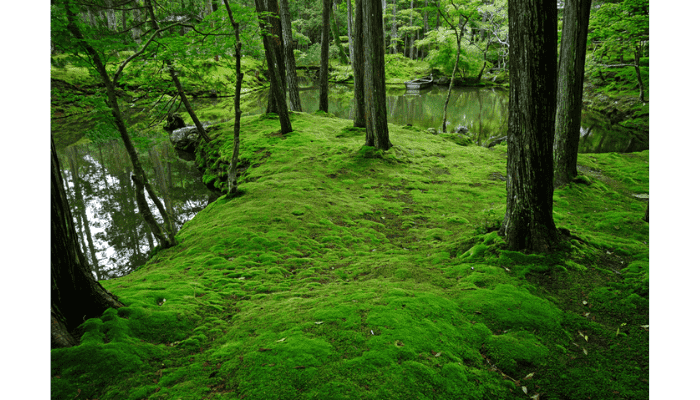
Visiting Kokedera (Saiho-ji) requires an advance reservation for a specific time slot.
In the past, anyone could visit freely, but due to the surge in tourism and increasing issues, the temple introduced a reservation-only system in 1977, limiting the number of visitors per session.
This system helps preserve the temple’s original purpose as a place of Zen practice, allowing monks to provide a more personal and meaningful experience for each visitor.
When I visited, I truly appreciated the peaceful and uncrowded atmosphere—a rare experience in Kyoto, where many popular temples are constantly packed with tourists. Saiho-ji offers a unique opportunity to immerse yourself in nature and tranquility without distractions.
How to Make a Reservation & Admission Fees
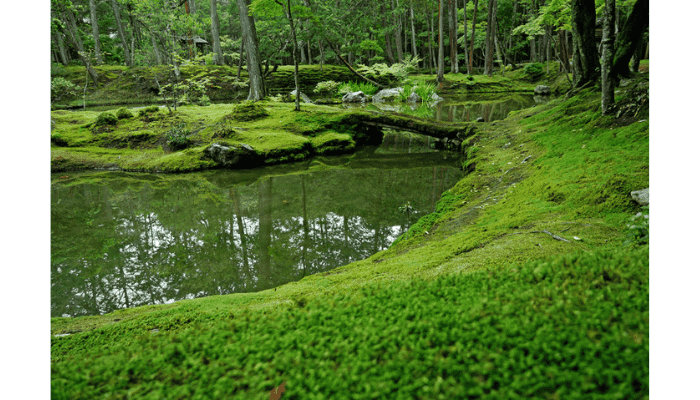
There are two ways to make a reservation: online or by return postcard (for details, click [here]).
- Admission fee: ¥4,000 per person (including tax)
- Online booking fee: plus ¥110 per person (including tax)
Online Reservation
- Visit the official website and go to the “Hibi Sanpai” page.
- Create an account and select your preferred date and time.
- Each account (or postcard application) can reserve for up to two people.
- If you have more than two people, you will need to create additional accounts. (For example, I visited with three people, so I created two accounts and made separate reservations.)
- Reservations can be made from two months in advance until the day before your visit.
- Payment is made by credit card at the time of booking, and you will receive a QR code for entry.
Reservation by Return Postcard
- Send a return postcard within the designated application period (postmarked between two months and one month before your visit).
- If your reservation is accepted, you will receive a reply postcard, which you must bring on the day of your visit.
- Payment is made in cash upon arrival. (For details, click [here].)
Other Special Programs
Saiho-ji also offers various guided experiences and exclusive events, such as:
- Temple staff-led guided tours
- Zen meditation sessions for members
- Early morning visits
Check the official “Oriori Sanpai” page for schedules and details.
Important Guidelines for Visiting Saiho-ji
When visiting Kokedera (Saiho-ji), please follow these rules and guidelines:
- Maintain silence within the temple grounds.
- Photography is not allowed inside the main hall.
- All visitors must participate in a sutra copying session before exploring the garden.
- Winter closure: The Hibi Sanpai (Daily Visit) program may be suspended in winter. (For 2024, it was closed from January 9 to February 29, but the Oritori Sanpai (Seasonal Visit) program continued.)
Please keep conversations to a minimum, and avoid loud talking or laughter.
Take this opportunity to step away from the distractions of daily life. Walk through the moss-covered gardens in silence, calm your mind, and enjoy a moment of peaceful reflection.
How to Get to Kokedera (Saiho-ji)
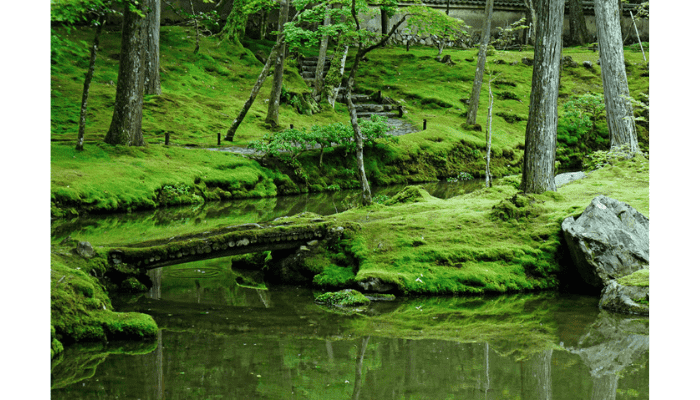
There are two main ways to reach Kokedera (Saiho-ji): by bus or by train. Below are the directions from JR Kyoto Station and Shijo Station (Subway Karasuma Line), two major transport hubs.
By Bus
You can take a Kyoto City Bus or Kyoto Bus directly to the temple. Since the bus stop is near Suzumushi-dera (Kegon-ji Temple) and Jizo-in Temple, it can get crowded on weekends and holidays.
- From JR Kyoto Station:
- Take Kyoto Bus No. 73 to Kokedera / Suzumushi-dera (about 60 minutes).
- Walk 2 minutes from the bus stop.
- From Shijo-Karasuma Station:
- Take Kyoto City Bus No. 143 to Suzumushi-dera / Kokedera-michi (about 60 minutes).
- Walk 2 minutes from the bus stop.
By Train
Take the Hankyu Line from Karasuma Station.
- Walking Route:
- Take the Hankyu Kyoto Line from Karasuma Station to Katsura Station (transfer).
- Take the Hankyu Arashiyama Line to Kami-Katsura Station.
- Walk 19 minutes to the temple.
- Total time: About 30 minutes.
- Train + Bus Route (Faster and Less Crowded):
- Take the Hankyu Kyoto Line from Karasuma Station to Katsura Station (transfer).
- Take the Hankyu Arashiyama Line to Matsuo-Taisha Station.
- Take Kyoto Bus No. 63 to Kokedera / Suzumushi-dera.
- Walk 2 minutes to the temple.
- Total time: About 28 minutes.
While the bus is the easiest option, combining train and bus cuts travel time in half and helps avoid crowds.
Saiho-ji (Kokedera)
- Address: 56 Matsuo Kamigaya-cho, Nishikyo-ku, Kyoto
- Google Maps: Click here
- Access:
- From Kyoto Station: Take Kyoto Bus No. 73 or No. 83 to Kokedera / Suzumushi-dera (about 60 minutes).
- From Saga-Arashiyama Station: 10 minutes by taxi.
- Phone Number: +81-75-391-3631
- Closed on: August 14, December 30 & 31
- Opening Hours:
- Open only in the morning (around 10:00 AM – 12:00 PM).
- Advance reservation required.
- Entrance Fee:
- Postal Reservation: ¥3,000 per person.
- Online Reservation: ¥4,000 per person.
- Important Notes:
- Postal reservations must be made 2 months to 2 weeks in advance.
- Online reservations can be made from 2 weeks before up to the day before your visit.
- Official Website: Saiho-ji Temple
Must-See Highlights of Kokedera (Saiho-ji)
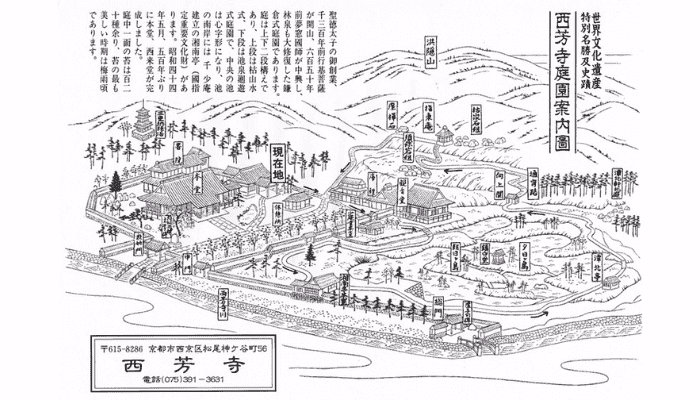
Kokedera is famous for its lush moss-covered landscape, but there’s much more to explore. Based on my visit, here are some of the temple’s most fascinating highlights.
Pond Strolling Garden
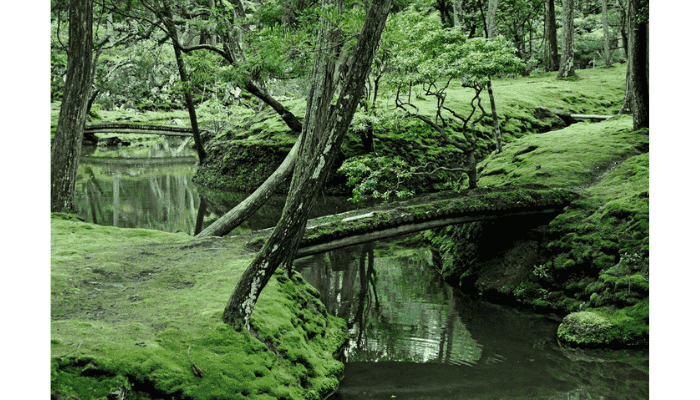
Kokedera’s garden, designated as a Historic Site and Special Place of Scenic Beauty, is actually two-tiered.
- The upper tier, a dry rock garden (Karesansui), is not open to the public.
- Visitors can explore the lower tier, a pond strolling garden (Chisen-kaiyushiki Teien).
When it was originally designed in the Muromachi period (1336–1573), the garden featured white sand and pine trees, reflecting the classic Japanese garden style. However, after being damaged by wars like the Onin War (1467–1477) and repeated floods, moss gradually took over. By the late Edo period (1603–1868), the garden had transformed into the stunning moss-covered landscape we see today.
Over 120 Species of Moss
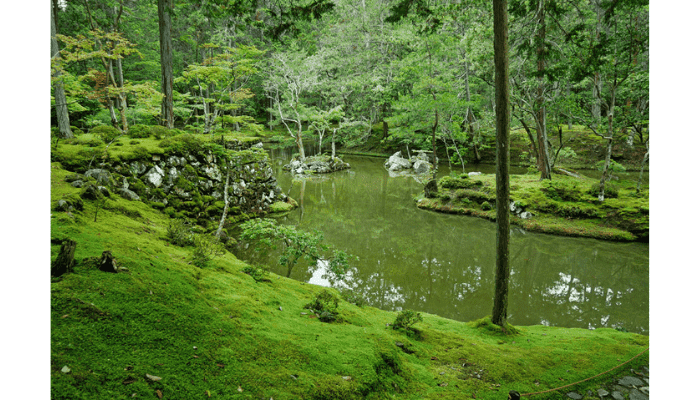
The entire 35,000-square-meter temple grounds are covered in moss, with more than 120 different species growing naturally. Some of these species are even listed as endangered.
Many of the moss varieties look quite different from what people typically imagine, making moss-spotting a surprisingly fun experience. Even if you don’t know much about moss, simply observing the rich textures and shades of green can be mesmerizing.
Kogane Pond
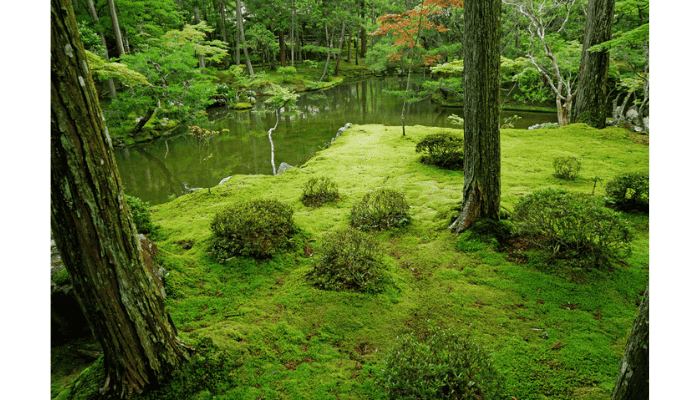
At the center of the garden lies Kogane Pond, which is said to be shaped like the Japanese character for “heart” (心).
Floating on the pond are two small islands, Asahi-ga-shima (Morning Sun Island) and Yuuhi-ga-shima (Evening Sun Island). A small shrine dedicated to Inari Myojin, a deity of prosperity and agriculture, stands on one of these islands.
Near the edge of the pond, you might notice a small boat. It is said that shoguns from the Ashikaga family once used boats to admire the garden from the water, adding to the tranquil and historical atmosphere.
The Stunning Reflection of Autumn Leaves
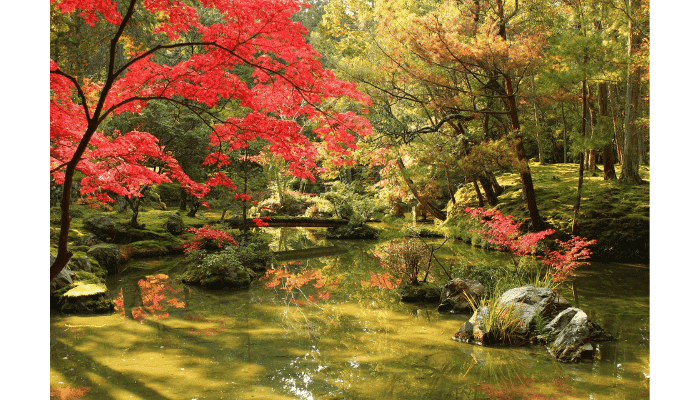
One of the most captivating aspects of Kokedera is how it changes with the seasons.
When I visited in November, some of the trees had turned brilliant shades of red and orange, creating a breathtaking contrast against the deep green moss. The reflection of these autumn leaves in the pond made the scenery look almost unreal, as if it had been painted.
In contrast, spring and summer bring out the vibrant fresh greenery, making the moss appear even more lush and radiant. Winter offers a different kind of beauty, as fallen leaves rest on the moss-covered ground, creating a scene full of wabi-sabi—the Japanese appreciation of imperfection and transience.
Shonan-tei
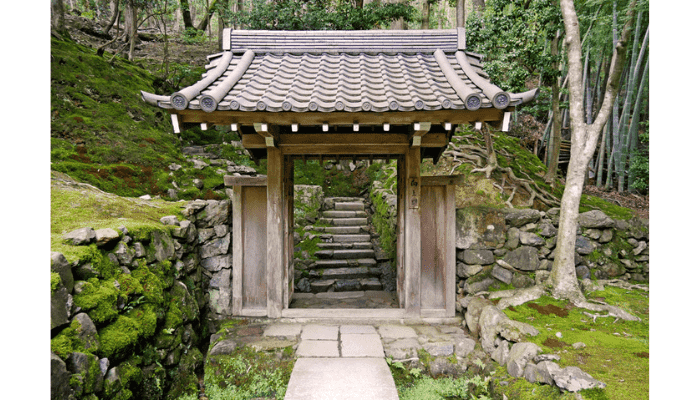
Shonan-tei is a tea house built during the Momoyama period by Sen Shoan, the adopted son of the famous tea master Sen no Rikyu. It is the oldest structure in the temple grounds and has been designated as an Important Cultural Property of Japan.
In the late Edo period, Iwakura Tomomi, a nobleman who supported the overthrow of the shogunate, hid here after being placed under house arrest by the Tokugawa government. One of the tea house’s most distinctive features is its north-facing moon-viewing platform, offering a beautiful reflection of the moon on Kogane Pond.
Chumon Gate
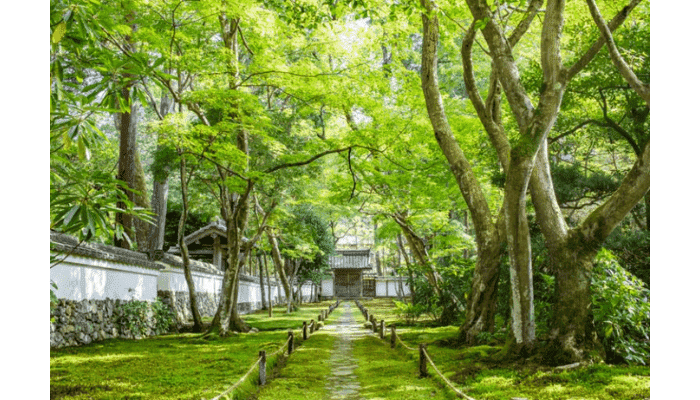
Located near the entrance to the garden, Chumon Gate is one of the most photogenic spots in Kokedera. Although the gate is now closed, it once connected the main approach to the outer gate of the temple.
When I visited in mid-November, the autumn leaves were just beginning to fall, but I heard that a little later in the season, the ground becomes covered in a stunning red carpet of maple leaves.
If you want to take photos in a peaceful atmosphere, I recommend booking the earliest or last visiting slot to avoid crowds.
Main Hall
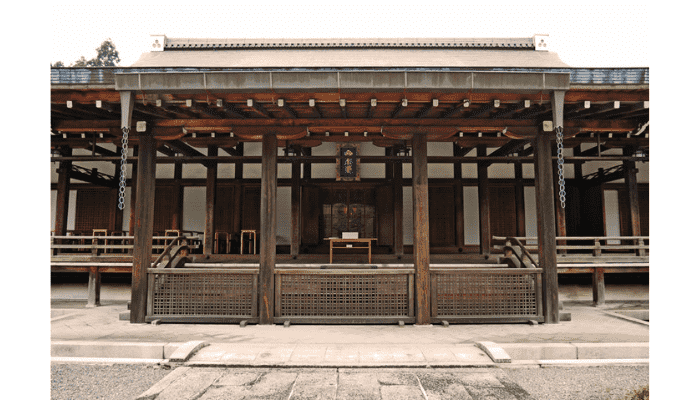
The main hall, known as Sairaido, was named by Musō Kokushi, the Zen master who restored Saihō-ji. The hall enshrines Amida Nyorai and serves as a place for sutra copying (shakyo) and other Buddhist practices.
Inside, you will find 104 abstract paintings on the sliding doors (fusuma). In front of the hall, there is a natural spring called “Yūhi no Shimizu” (Sunset Spring), which has been flowing for about 1,400 years, since the time of Prince Shōtoku.
Sutra Copying
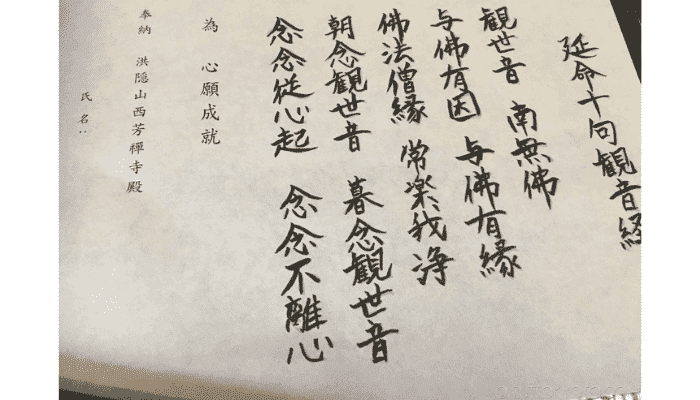
Before exploring the garden, visitors practice shakyo (sutra copying) in the main hall to calm their minds.
The text used is the Enmei Jukku Kannon-kyō, a short, easy-to-copy sutra, making it accessible even for visitors from countries that don’t use kanji. It takes about 15 minutes to complete.
The hall was filled with international visitors, all of whom participated in silence with deep focus.
Once finished, you can either leave your sutra at the temple for a ceremonial burning (ofuda-yaki) or take it home as a keepsake. I chose to bring mine home and display it.
Yasunari Kawabata’s Stone Monument
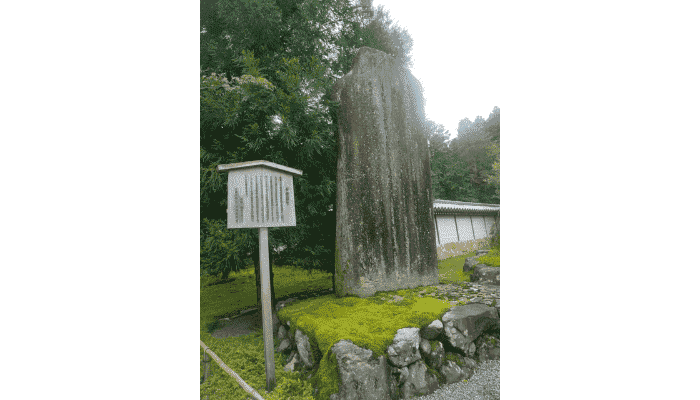
As you pass through Shumyōmon, the temple’s entrance gate, you will see a large stone monument on the left.
This monument features an excerpt from “Kikyō” (Homecoming), a novel by Jirō Osaragi, a writer who helped popularize Kokedera. The text was handwritten by Yasunari Kawabata, the Nobel Prize-winning author.
Kokedera has deep ties to literature—you can also find a stone monument engraved with a haiku by Kyoshi Takahama near the main gate. The temple has appeared in many literary works, including those by Kawabata himself.
The Main Gate (Sōmon)
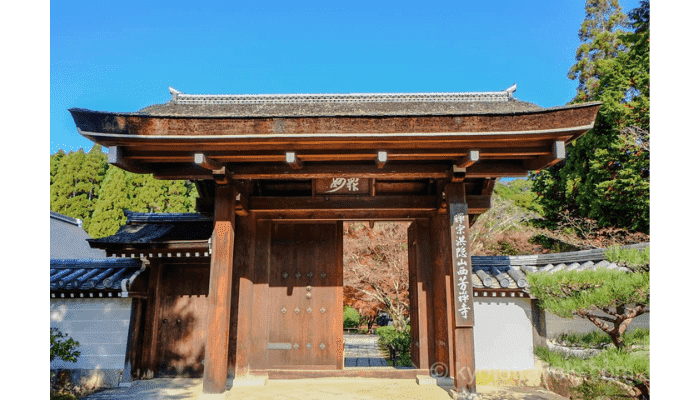
As you walk from the bus stop or train station, the first landmark you’ll see along the Saikōji River is the temple’s main gate (Sōmon).
However, since the introduction of the reservation-only system, this gate has remained closed to the public for many years.
In autumn, the area transforms with brilliant red maple leaves, creating a stunning contrast with the bridge and the gentle sound of the river. It’s a perfect spot to pause and take in the scenery.
Goshuin
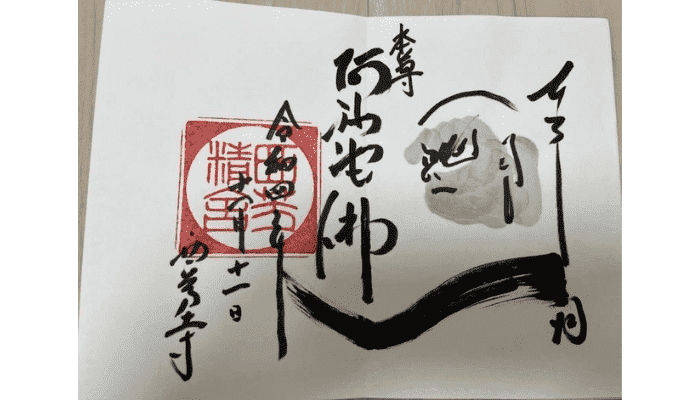
Kokedera’s goshuin (temple seal) is a special two-page design. True to Zen teachings, it is simple yet powerful, without excessive decoration.
You can request a goshuin at the reception desk near the entrance of the main hall for 500 yen.
While pre-written versions are available, if you’d like it written directly into your goshuin book, be sure to submit your book before the sutra copying session and pick it up afterward.
Kokedera (Saihoji) – The Moss Temple of Kyoto
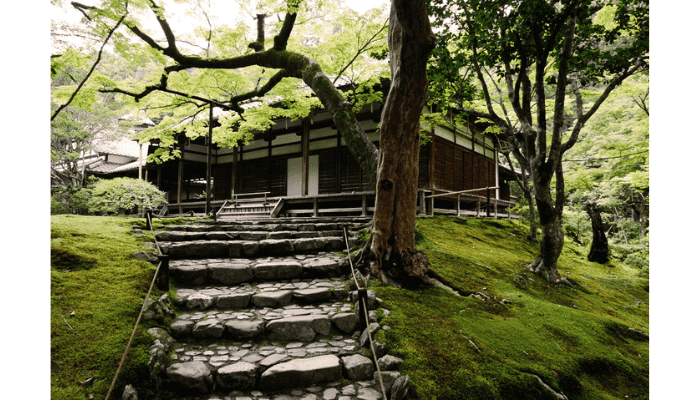
Kokedera, or Saihoji Temple, is famous for its breathtaking moss-covered garden. While advance reservations are required, this system helps prevent overtourism, allowing visitors to enjoy the serene beauty of nature in peace.
The sutra-copying experience (shakyo), which many people rarely get a chance to do, is a wonderful opportunity for self-reflection. By putting away your smartphone, keeping conversations to a minimum, and focusing on the present moment, you can fully embrace the spirit of Zen.
Saihoji Temple (Kokedera)
- Address: 56 Matsuo Jingatani-cho, Nishikyo-ku, Kyoto
- Map: [Google Maps]
- Access:
- From Kyoto Station: Take Kyoto Bus #73 or #83 (bound for Kokedera/Suzumushidera) and get off at Kokedera/Suzumushidera. The temple is a 2–3 min walk from the bus stop.
- From Saga-Arashiyama Station: About 10 minutes by taxi.
- Phone: 075-391-3631
- Closed: August 14, December 30, December 31
- Visiting Hours:
- Open only in the morning, typically from 10:00 AM to 12:00 PM.
- Entry is limited to visitors with advance reservations.
- Admission Fee:
- 3,000 yen per person (by postcard application)
- 4,000 yen per person (by online application)
- Reservation Details:
- Postcard application: 2 months to 2 weeks before (postmark required).
- Online application: Available from 2 weeks before to the day before your visit.
- Official Website: [Saihoji Temple]
▼ Related Articles for Kyoto Sightseeing

